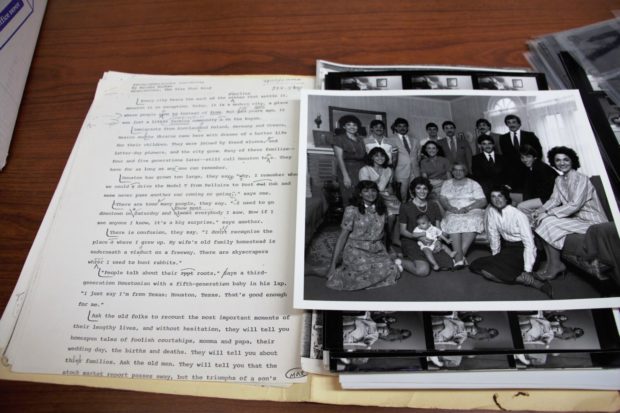

Longtime Houston photographer Janice Rubin donated much of her film photograph archives to UH Libraries Special Collection after Hurricane Harvey flooded her home. She began documenting Houston in 1976. “I used to go downtown on a Saturday and know most everybody I saw,” said one family member in the article accompanying the family generations portrait. “Now if I see anyone I know, it’s a big surprise.” | Michael Slaten/The Cougar
Four decades of Houston history has been documented by photographer Janice Rubin. From the boom town of the 1970s, to the large cosmopolitan city we now know, Rubin was there to photograph its growth.
In early 2017, Rubin was in the early stages of donating her photograph archives to the University of Houston Libraries Special Collections. It was important to her that the work be accessible long term.
On Aug. 25, 2017, Hurricane Harvey made landfall. Her home took in fifteen inches of water during the storm. Thousands of her photographs were lost.
“I worked out of my house,” Rubin said, “I lost a lot of files, journals, all the photography that was in bottom drawers.”
After the waters receded, Rubin worked in earnest to get her work organized, scanned and donated sooner rather than later, before more could be lost.
Rubin secured funding from the Harvey Arts Recovery fund. With that money, she hired a UH student to help her prepare her archives for donation. What would have taken 10 years only took one, she said.
Now, much of her film work from 1976 to 2002 will permanently reside in Special Collections.
Documenting Houston
When Rubin began photographing Houston in the mid 1970s, Houston’s population was under 1.5 million. She worked for several magazines in the area.
In the archives she donated, there are photographs of nearly every political mover and shaker that helped shape the city, including former congressman Mickey LeLand and Cynthia Mitchell.
There are also photos the Klu Klux Klan, Gilley’s club and even a young Jim McIngvale, better known as Mattress Mack.
“I really had a unique opportunity to see Houston from its time as a boom town, a place where the whole world was interested in, ‘What is this Houston?’,” Rubin said.
Most of the families living in Houston at the time did not come from generations of native Houstonians, Rubin said. She took interest in finding and photographing the rare families who were.
In 1978, Rubin found and photographed families that had four generations of native Houstonians. There might have been a grandparent who was born in the 1890s or early 1900s, she said.
“I remember when we could drive a Model T from Bellaire to Post Oak and never pass another car coming or going,” said one family member Rubin photographed for an article written by Marsha Walker, which can be found in the donated archives.
In the 1970s, cafes, flower shops and all kinds of businesses were open 24 hours a day, Rubin said. Now, Rubin says Houston is a cosmopolitan place.
“Houston felt like this vibrant place that everybody wanted to come here and be an entrepreneur,” Rubin said. “Houston made it possible.”
Flooded history
Except for studs, Rubin’s home is now bare. There are no floors, no doors and no walls. She lives in a leased property.
After her house was flooded, Rubin began searching for what remained of her belongings. Photographs in bottom drawers were lost. A three-ring, 1,800 page binder with tear sheets containing every published piece of Rubin’s work was soaked.
From then until winter, she aired out each page in her garage. Then, she photographed what she could.
With the remainder of her work and assistance from the Harvey Arts Recovery Fund, Rubin began scanning, organizing and documenting in a spreadsheet all her work she was going to donate. She lost several thousand photos to the flood, and threw away an additional four or five thousand she thought wouldn’t be of any interest.
Rubin began shooting digital in 2002, but she plans to donate those archives as well, said Mary Manning, university archivist and curator of the performing and Visual Art Research Collection.
Anyone with an ID can visit the UH Library Special Collections to view Rubin’s life’s work.
“The Janice Rubin Photographs vary greatly in subject matter, making them valuable to people with various interests and researchers from different disciplines,” Manning said.
Rubin first got the idea for donating her work when she was contacted a few years ago by a man writing a book about the Houston art scene in the late 1970s and 1980s. Rubin had photographed a lot of it.
The man suggested she donate her work to UH. Rubin had known photographers who died without making arrangements for their collections.
“I wanted to think about some of it at least being preserved in an institution where it can be accessed by others who might learn some things about themselves and the history of Houston,” Rubin said, “and make their own meaning of the work.”
news@thedailycougar.com
—
“After Harvey: Native photographer donates nearly 30 years of Houston history” was originally posted on The Daily Cougar
